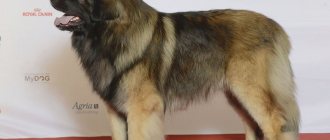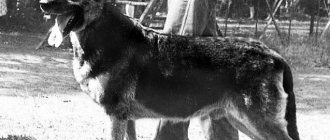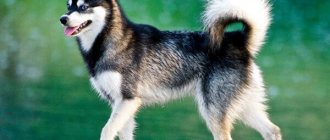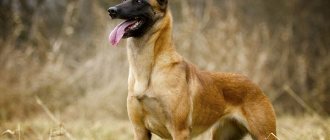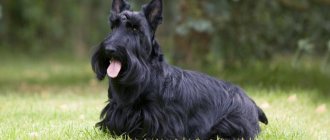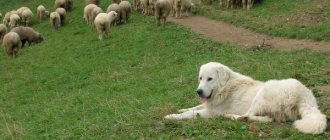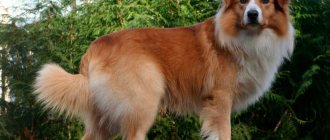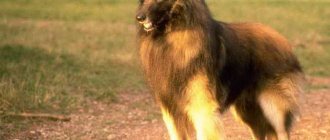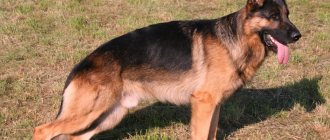a brief description of
- Other names: Dutch Shepherd, Hollandse Herdershond, Herderhunder, Danish or local shepherd, Dutch Herder, Dutch;
- Height: 60 – 63 cm;
- Weight: up to 35 kg;
- Color: gray, brown, golden brindle, black with gray, pepper and salt, all species have a black mask around the eyes;
- Wool: there are three types - wire-haired, short-haired and long-haired representatives of the breed;
- Life expectancy: up to 14 years;
- Difficulties: Unpresentable appearance. The owner has to gain the trust of deeply vulnerable and touchy pets for a long time. Dogs are not nannies for small children, but they are strong and real friends with teenagers.
- Price: $150 – $350.
brief information
- Country: Netherlands.
- FCI class: Shepherd dogs (herding and cattle dogs)
- Use: service dog, watchman, shepherd, companion.
- Color: brindle and its shades, gray-blue, fawn.
- Lifespan: 12-15 years
- Average weight: 29-30.5 kg.
- Height at the withers: females – 55-60 cm, males – 57-62 cm.
- Price: 35,000-60,000 rubles.
Photo: pxhere.com
Appearance
The Dutch Shepherd is a strong, well-proportioned, medium-sized, slightly elongated dog. Height at the withers for males is 57-62 cm, for females 55-60 cm, weight ranges from 30-40 kg.
The head is proportional to the body, elongated, not massive, dry. The muzzle is slightly longer than the flat skull. The bridge of the nose is straight, parallel to the skull. The stop is weakly expressed. The lips fit tightly. In wire-haired dogs, the head appears more quadrangular, which it actually is not. The ears are small, erect, set high, directed forward. The eyes are medium-sized, almond-shaped, set slightly obliquely, dark in color. The nose is black. Scissor bite, strong teeth.
The neck is dry, of medium length, smoothly blending into the upper line of the body. The back is short, strong, straight. The loin is strong, not too long and not narrow. The croup should not be sloping or short. The chest is deep, not flat. Ribs slightly arched. Overall the body is strong and well balanced. The forelimbs are strong-boned, straight, well covered with hair on the carpal joints. The hind legs are uniformly strong, with strong bones and good muscles. The stifles are moderately angulated and the metatarsals should be vertical under the ischial tuberosities, which is ensured by a moderate angle of the hock joint. There are no dewclaws. The paws are well assembled. The pads are dark in color, the claws are black. The tail is straight, hanging or slightly curved, reaches the hock joint, and rises slightly during movement.
Based on the quality of their coat, Dutch Shepherds are divided into three types:
- Shorthair; The coat is short, hard, with a rich undercoat. The collar, trousers and hair on the tail are very well developed. The color is brindle on a brown or gray base. Stripes run along the entire body, as well as on the collar, pants and tail. A large amount of black topcoat is undesirable. A black mask is encouraged.
- Long-haired; throughout the body the coat is long, straight, rough to the touch, and does not form curls or waves. The undercoat is well developed. The hair on the head, ears, paws and hind legs below the hock is short. The back side of the forelimbs is covered with feathers. The tail is well bushed, but without fringe. The color is the same as that of the short-haired variety.
- Wirehaired; The coat is dense, hard, tousled except for the head. The undercoat is well developed and dense. Everywhere the wool should be tightly closed. On the head, the hair forms a mustache and beard, as well as disheveled eyebrows. On the skull and cheeks the hair is less developed. Plentiful pants are encouraged. The color is grey-blue, pepper and salt, golden or silver brindle. In brindle dogs with a hard coat, the stripes on the top coat are less pronounced than in other varieties.
The presence of large white spots on the chest and paws, as well as anywhere else on the body, is not welcome.
Flaws
Disadvantages include physical and mental deviations from the standard; if they do not affect the quality of life, then the pet will live a long and happy life, but without participation in exhibitions and access to breeding.
The most common of them:
- Lack of uniform color, presence of white spots in large quantities;
- Preventing the testicles from entering the scrotum in male dogs;
- Lack of correct bite, misalignment of the jaw, lack of a full set of teeth or fangs, crooked front teeth;
- Unpainted eyelids, nose or lips;
- Insufficient color of the iris;
- Too large or small bone;
- Distortion of the lower back, shoulder, back;
- Short back, neck, lower back;
- Insufficiently developed muscles, low weight;
- Slanted croup;
- Too wide and large head;
- Light cartilage, recumbent ears;
- Mental disorders - cowardice, aggression;
- Tail crease;
- Round chest;
- Neck too long;
- Different eye colors;
- No black mask;
- Scanty wool.
International standard. Description
The Netherlands is the birthplace of Dutch Shepherds (Herders). There are three varieties of this breed:
- shorthair;
- long-haired;
- Wire-haired.
The first two species have the same colors - yellowish or silver coat interspersed with black stripes. During molting, the light undercoat is more noticeable, after which it becomes darker. Wire-haired dogs are allowed blue-gray or pepper-and-salt coloring. Breeders in the Netherlands are trying to achieve a spotted color with a golden tint, but to no avail.
Longhaired Dutch Shepherds
Upon visual inspection, the dog gives the impression of a proportional, light, smooth, medium-sized predator. With straight lines of the back and loins, a strong lean body, without dampness. The length of the body is greater than the height at the withers. The stomach is moderately tucked. The chest is narrow, but deep and drooping. The tail at rest reaches the hocks, is strong at the base, saber-shaped, and set low. The limbs are light but strong. The features of typical shepherd dogs, in particular Belgian ones, are clearly visible.
The head has clear lines, wedge-shaped. Wirehairs have a larger appearance due to the type of coat. The neck is dry, without dewlap. The skull is slightly shorter than the muzzle. The transition from the forehead to the nose is moderately pronounced. The eyes are almond-shaped, not protruding, dark brown in color. The look is expressive, intelligent. The ears are triangular in shape, set high, slightly pointed at the ends, erect. Bite – scissors, standard – 42 teeth. The nose is not large with wide nostrils, black (white pigment is not allowed).
Dutch Herder breed standard
Height at the withers for males is 58-60 cm, for females 55-58 cm. Weight for males is from 27 to 29 kg, for females 24-27 kg.
Comparative classification of Dutch Shepherds, according to the International Canine Federation: group 1 (herding and cattle dogs), section 1 (shepherds).
Origin story
So little is known about the Dutch Shepherd breed outside the Netherlands that it is sometimes mistaken for the most “pedigree” court terrier or a ferocious wolf dog mixed with several breeds.
A direct descendant of the Belgian Shepherd, Herderhunder - the official name of the Dutchman, which has been assigned to him since 1860, was bred for a specific and quite noble purpose. In cattle breeding, the herding and guarding qualities of dogs, with which the Herder is endowed to the highest degree, have been and will continue to be of the highest degree of importance.
Story
It is believed that this breed was developed in the 19th century based on the ancestors of the Belgian Shepherd. It was first officially presented at the Amsterdam Dog Show in 1878 under the name "Local Sheepdog". The first breed standard was registered in 1898.
The breed received international recognition only in 1955, when it was registered with the Fédération Cynologique Internationale (FCI). The Dutch Shepherd standard was last adjusted in 2009.
Did you know? The word "herder" means "shepherd" in Dutch. The full name of the breed in the Netherlands is Hollandse Herdershond, that is
«
Dutch Cattle Dog
»
.
Purpose of the breed
Working qualities are inherited by the headers. Dogs of this breed were never bred for commercial purposes, so the exterior of the city shepherd is somewhat simple, but they are without a doubt considered the best shepherds among similar breeds.
Dutch Herders are also incredibly intelligent, learning canine science quickly and efficiently . Dogs make excellent guards and rescuers, shepherds and guides, athletes and companions. Dogs of this breed can be kept by large families and elderly people, since Dutch dogs tend to instantly adapt to the rhythm of life of the owner.
Herder history
The history of the Herder is practically not recorded in official publications; it is believed that the Dutch Shepherd is an intermediate form between the Belgian and German. Unlike its relatives, such as the German Shepherd, the Herder has never been a fashionable or popular breed. He is an ordinary representative of European Shepherds.
For several centuries, the shepherd dogs of Holland, Belgium and France were practically no different from each other. They were exclusively workers and performed various guard duties, although they were more often used for herding and guarding sheep. Farmers did not pay any attention to the color of the dogs or the structure of the coat. For the Dutch Shepherd, it was more important to have the correct position of the limbs, a strong back and well-developed muscles.
Character
Herderhunder is considered a great success for Dutch breeders . A dog with a moderately active temperament has a calm and balanced character , showing a moderate degree of aggression only towards a suspicious object. Without a reason, a dog will never give a voice and will not attack first, even in the event of an unauthorized intrusion by uninvited guests.
Once in a new home, a Dutch woman takes a long time to get used to the person. But as soon as a dog accepts its owner as the leader of the pack, it becomes the most loyal creature. Dogs have difficulty withstanding loneliness , since Herders have a highly developed sense of herding. Once in a house with a large farm, where there are birds and artiodactyls, dogs get used to it less painfully.
The Dutch Shepherd also knows how to make friends and loves not for something, but because. The high level of friendliness extends to all inhabitants of the house; the dog avoids only small children , expressing complete indifference. But this is only until the child grows up and begins to take part in games with the dog.
External unpresentability is fully compensated by the rich inner world, friendliness and devotion of the Dutch Shepherd breed, the price of which has been quite low for a long time. But behind the luxurious exterior, the working qualities of the breed are often lost, which, fortunately, has not happened over the past hundred and fifty years with the Herder.
Attitude towards children and others
The Dutch Shepherd (Herder) treats its owner with love and devotion. In relation to other family members, the dog is affectionate and shows tenderness. He treats children with care and patience, protecting them from potential danger.
The dog's attitude towards strangers is wary, however, without expressed aggression. Safe for others if they do not encroach on his home or threaten the lives of family members. Security qualities in a dog are inherent at the genetic level.
If a shepherd dog actively interacts with other dogs during training, then during walks it does not show aggression towards them. The pet will not act as the instigator in a fight.
Security qualities
Dutch Shepherds, thanks to their lively mind and quick wit, quickly understand what is wanted from them. Therefore, they can serve as faithful guards of a house, plot or owner. Innate caution and attentiveness, acute hearing and vision are undeniable assistants in protection.
Herders can serve at any time, in any weather conditions. They are unpretentious and hardy. Always ready to please the owner.
Features of character and behavior
Dutch Shepherds are very active, balanced animals with a strong territorial instinct. Communication skills are not very developed.
Advantages
- Unlike their German brothers, Herderhunders rarely bark, especially if there is no reason to do so.
- They are not choleric, although they are quite cheerful, active, and love to play.
- Shepherd dogs are balanced, calm, and non-conflict.
- They do not start fights with their brothers, and do not attack without reason.
- They are easy to control at work, they obey commands and obey the authority of their owner. The owner is a leader for them; the Dutch are very attached to him, devoted, and strive to receive praise.
- Herders get along well with other animals. They will be especially pleased with the presence of chickens, piglets, sheep, that is, animals that can be grazed. They will do this with gusto all day, feeling their importance.
- Dogs get along with children, especially active ones; except for the smallest ones, they usually ignore them and do not show aggression.
- Like other shepherd dogs, Herders are good guard dogs. They carefully monitor the situation around them, read the plans of strangers, and good hearing and vision only help in this.
- Although dogs are not inclined to attack without reason, if necessary, they bark, scaring away the intruder, and can attack when absolutely necessary.
Flaws
One of the main difficulties is not very developed communication skills. The dog is wary of everything new. The owner will have to gain the puppy's trust; he needs to be socialized as early as possible. If the owner manages to establish contact, the dog will obey; if not, the Herder will take the position of leader and ignore commands and attempts to educate.
- Representatives of this breed have a hard time experiencing any changes, moving, new enclosures depress him. It is especially difficult for him to change his owner.
- The dog trusts new people little, does not strive to make contact, and is distrustful. At the same time, the Herder cannot stand loneliness and greatly misses attention.
- Animals of this breed are touchy and vulnerable, do not tolerate rude words and harsh treatment, even from the owner.
- You need to be persistent in training, but without going overboard, otherwise the dog will build an “ice wall” around itself for a long time.
Care and maintenance
For the unpretentious and undemanding Danish Shepherd, the ideal living conditions are a private house or a country residence. A dog needs space, and the presence of living creatures will instinctively simplify the period of adaptation to new living conditions.
In a city apartment, the Herder needs long walks. Therefore, seasonal treatments for fleas and ticks, no matter what conditions the dog is kept in, become vitally necessary, because the bite of an infected blood-sucking parasite can cause not only allergic skin dermatitis.
The Danish Shepherd is a groomer's sadness. They are not cut and practically not bathed, since dog cosmetics are contraindicated for herders . Paws that get dirty during a walk are rinsed with plain water and wiped dry. Brush once every two weeks. For long-haired individuals - once every seven to ten days. Wirehaired Shepherds are trimmed twice a year.
Dogs have a strong dental system, as befits a guard, and their eyes are not reactionary. Ears are cleaned once a week if necessary. Nails are trimmed as they grow, unless the dog grinds them down while walking.
Nutrition
Dutch Shepherds are not usually picky eaters. Easily adapts to any type of feeding. Natural diets for them are developed according to standard rules. If for some reason it is impossible to provide your dog with a complete, balanced diet of natural products, it is better to switch to ready-made dry food. Dutch diets are suitable for medium and large dogs that lead a normal or active lifestyle. As for flavoring fillers, attention is paid to the preferences of the animal.
Care
Herder does not require complex care. When working with a breed, it is important to take into account the characteristics of the coat, content and age. Recommendations for caring for a Dutch Shepherd:
- monthly inspect the ears, clean wax accumulations;
- in the summer, the claws grind down on their own; in the winter, they should be trimmed every month;
- check the condition of the eyes, clean them from dirt. If necessary, use special veterinary drops;
- How often you brush your teeth depends on your age and diet. When drying, the procedure is carried out less frequently than when drying. The optimal frequency of cleaning by a veterinarian is once a year. For prevention, allow chewing on dense treats, use a special paste;
- Hair care varies depending on its type. Brushing should be done weekly, especially during shedding periods. Only long-haired dogs need a haircut. Wire-haired representatives of the breed are trimmed 2-3 times a year, show dogs are plucked monthly;
- bathing is necessary 2-3 times a year; if the dog lives in an apartment, the procedure can be performed more often.
The pet should have its own place in the house, for example, a bed without sides. It is recommended to purchase only metal bowls, with the ability to adjust the stand to the height of the dog.
Photo: maxpixel.net
How to position the ears
Raised ears are a key feature of the breed and a prerequisite for exhibition. They are specially placed in puppyhood. A simple way to put ears on a Dutch Shepherd:
- Treat the sinks with a cotton pad soaked in hydrogen peroxide or Chlorhexidine.
- Place your ears vertically and place an ice cream stick or similar object made of natural materials nearby.
- Tape them with medical tape, creating a bridge between the ears.
Change the patch and sticks every 4-7 days or when soiled. With this method, the puppy’s ears stand up after 3-4 weeks. During this time, give vitamin and mineral supplements rich in calcium.
Health and illness
The Dutchman is hardy and has a strong immune system. Representatives of the breed do not have genetic diseases. However, throughout its life, the pet can suffer from classic canine diseases.
To avoid them, it is necessary to vaccinate annually, as well as follow the rules of caring for the dog. Also, in the adulthood of the dog, senile diseases cannot be ruled out. If you notice symptoms of illness in an animal, you should take its temperature and, if necessary, contact a veterinarian.
Lifespan
A dog's good health allows it to live for many years. On average, a dog lives about 12-13 years. However, with proper care, the pet will delight its owner for several years longer.
Vaccinations
The Dutch Herder requires the same measures to prevent dangerous diseases as other dogs. Vaccination against diseases such as:
- viral hepatitis;
- rabies;
- carnivore plague;
- parainfluenza;
- coronavirus;
- trichophytosis;
- paravirus;
- leptospirosis.
Herder puppies are vaccinated for the first time after 7 weeks, and then at 12 weeks of age. Next, the Dutch Shepherd is vaccinated annually according to a schedule drawn up by a veterinarian. Animals that are sick, weak or infected with parasites should not be vaccinated. Puppies from each procedure are quarantined for 2 weeks.
Training and education
Incredibly flexible and attentive, Dutch Shepherds are very easy to train. Dogs learn quickly, grasping everything on the fly and instantly remembering commands.
The puppy needs to be introduced to the rules of behavior and socialized from a very early age, otherwise he may grow up to be fearful and unsociable. When training, it is extremely important to act confidently, consistently and patiently, as independent Shepherds tend to be stubborn. The owner must be a leader and authority for the dog.
Dutch Shepherds are highly trainable and participate in various dog competitions.
When working with Dutch women, cruelty and physical punishment are excluded.
Mating
Breeding the Dutch Herder must be done carefully, always avoiding accidental mating. It is necessary to choose a partner carefully, even within a breed, since short-haired, long-haired and wire-haired varieties should not be crossed with each other.
Mating of a Danish Shepherd can be carried out when the dog has reached the age of 2 years. Mating always takes place in the male dog's territory. The pedigree qualities of the male must be equal to or exceed the class of the female.
In order to guarantee pregnancy, mating is carried out again after a day.
Pregnancy
The gestation period for Shepherds varies from 50 to 56 days. During this time, the animal should be provided with high-quality and balanced nutrition, and serious physical and psychological stress should be avoided. The litter of this breed is small - 4-6 puppies; the first time a female produces fewer offspring. It is advisable to carry out childbirth only under the supervision of a veterinarian in order to avoid unpleasant consequences and carry out the necessary resuscitation measures in a timely manner.
The Dutch Shepherd has good maternal instincts. After giving birth, the bitch's guarding skills may become more acute. To prevent such changes, ensure that your pet is kept in a comfortable and quiet environment during this period.
Estrus
In the Dutch Shepherd, the first heat occurs between the ages of 6 and 11 months. Normally, it lasts from 20 to 23 days, and then repeats with regularity up to 2 times a year. The dog's behavior and habitual way of life changes. The bitch becomes more lethargic or active, and her appetite changes. The main sign of the onset of estrus is increased urination and an increase in the size of the labia. During this period, all walks should only be on a short leash. It is advisable to wear special underpants indoors to make caring for your pet and cleaning up during discharge easier.
Diseases
The Dutch Shepherd does not have any serious hereditary diseases. A common problem for Herders is hip dysplasia. To avoid this disease in your pet, it is important to request pictures of the litter's parents. As a rule, large breeders and nurseries do them before planned mating.
With illiterate care and maintenance, there is a risk of bedsores and alopecia. In old age, dogs often experience decreased vision and develop cataracts or blindness. The lifespan of a shepherd dog can be up to 15 years. Like other breeds, puppies require routine vaccinations starting at 2 months.
Choosing a puppy
Five to ten puppies are born in a litter. Since the breed is considered genetically healthy and strong, all puppies are very active. Naturally uncommunicative, they are wary of strangers. When choosing a puppy, you should pay attention to the absence of signs of helminthiasis. A swollen belly in a baby of this breed is more likely to indicate worms than rickets.
Breeders recommend taking the baby to a new home as early as possible - immediately after the first vaccination. Dogs take a long time to get used to new people, and it is necessary to gain the puppy’s trust so that he recognizes the owner as his master. You should also get full advice on raising a young Herder:
- What methods should be used to teach him to go to the litter tray for the first time?
- When to revaccinate.
- What, how and how many times a day to feed a Herder puppy.
The main aspect in the process of raising a puppy is considered to be the choice of behavior tactics with the dog, since they have a difficult character even in puppyhood.
Price
At home, the cost of a good baby with a pedigree is from 1200 euros, litters without documents from 300 euros. In the Russian Federation, the cost starts from 30 thousand rubles and can grow to 1000 euros. The best puppies of the litter, on which high hopes are pinned, can cost about 2000 thousand euros.
Nicknames and names
At birth, each puppy receives an official name according to the letter of the kennel's stud book. The pet name, often radically different from the official nickname, is given to the puppy by the owner.
Recently, it has become prestigious to give Herders Dutch names. They are named after famous people in the Netherlands. They give a name in accordance with the Dutch geographical names of cities and localities.
Sometimes the name matches the color of the pet. In rare cases, the breeder gets it right, and the puppy's official name remains the current name without changes.
Puppies
Small herders differ from adults only in color. Energetic behavior is characteristic of both adults and puppies. There can be from 5 to 10 of them in a litter. They are rarely born with any abnormalities due to the excellent health of the breed.
The final color of a Herder puppy is formed by the age of one year.
Before adopting a puppy, it is recommended to get advice on maintenance, vaccinations and feeding from the breeder.
Reference! Dutch Shepherd puppies are born completely black, and closer to two months of age, tiger stripes begin to appear. And only closer to a year does the dog acquire a permanent color.
Pros and cons of the breed
Among the advantages of the breed are:
- loyalty;
- affection;
- lively temperament;
- reasonableness.
disadvantages , but you need to pay attention to them:
- need for a leader;
- touchiness.
Sources
- https://www.moiasobaka.com/vse-o-porodah/srednie/gollandskaya-ovcharka.html
- https://usatiki.ru/gollandskaya-ovcharka/
- https://HiDogs.ru/porody/gollandskaya-ovcharka-herder/osobennosti-i-uhod-za-ovcharkoy.html
- https://www.PorodiCobak.ru/porody-sobak/gollandskaya-ovcharka
- https://ovcharkin.ru/porody/herder.html
- https://dogipediya.ru/porody-sobak/bolshie/gollandskaya-ovcharka
- https://prohvost.club/sobaki/porody-sobak/foto-gollandskaya-ovcharka.html
- https://PetGuru.ru/porody/gollandskaya-ovcharka-herder
[collapse]
How to choose a puppy
At first glance, Herder puppies look like wolf cubs or an unfortunate mix of several medium-sized breeds. The color can vary from golden-brown to brindle with silver or golden stripes. When choosing a puppy, it is important to remember that this breed of dog does not come in one color and pay attention to this. The exception is long-haired Herders. But their long black hair is usually either gray or silvery.
The puppy's ears should be triangular, like a German Shepherd's. In short-haired dogs, the fur inside the ear should definitely be darker than the outside. The head is small and practically merges with the muzzle of medium length without a sharp transition. The body is strong, with a powerful back and lower back. The paw pads are black, like claws, regardless of the base color.
The best option is to buy a puppy at the age of 1-2 months. This way you will get a full-fledged family member and a devoted pet. But Herders adapt quickly, so finding a common language with a 4-6 month old pet will not be difficult. But an adult dog can only be adopted by experienced dog breeders and in no case by hand, but in a kennel.
Characteristic
According to the breed description in the FCI registry, the Dutch Shepherd was once exclusively a herding dog, used primarily for herding sheep. However, nowadays it is used mainly as a companion dog, used as a service dog in the police and rescue services, and as a guide dog for the blind.
Outwardly, this is a rather large dog, its height is approximately 60 cm at the withers, proportionally built, not massive, but not fragile either. The expression of the muzzle is quite stern, but this impression is created due to the structural features of the head of this shepherd dog. Some find that Herders look like an unfortunate cross between different breeds, but this is a matter of taste. There are three varieties of Herder: shorthaired, longhaired and wirehaired.
Did you know? No more than three hundred Dutch Shepherd puppies are born in the world every year.
The Shorthaired Sheepdog is the most common variety. These dogs are covered with hard, thick, close-lying hair with a thick undercoat. The color is usually brindle with golden or silver stripes.
Wirehaired dogs have a hard, shaggy coat. Their heads appear rougher and squarer than other varieties, but this is an illusion. The coloring follows that of short-haired dogs.
Long-haired shepherd dogs are the smallest variety. They have a thick, long, straight coat - according to the breed standard, wavy or curly is not acceptable. The color of this variety may differ from others. In particular, there are dogs of a dark, uniform color, sometimes with a silver tint.
The easiest way to buy a Dutch Shepherd is in the Netherlands. There their cost is 700-800 euros.
Skin pigmentation
Particularly expressive to the representatives of the breed is the mask - the part of the muzzle around the eyes, which is most often completely black. The dominant gene is responsible for it. If the animal's fur is dark in color, the mask is often weakly expressed. A pet with a light coat has a more saturated color of the mask. Its absence is considered a breed defect.
The black and tan animal does not have a mask, its muzzle is black. The throat area is colored brown, the edging of the lips is liver-colored.
The color of the eyebrows and forehead of saddle-backed shepherd dogs directly depends on the tone of the saddle coat. If its color is deep dark, then the animal’s forehead is also charcoal. An expressionless lightened mantle is in harmony with light eyebrows.
Note! The zone-colored German Shepherd has sable eyebrows.
These are the main color options for shepherd dogs. Those who want to engage in breeding or take part in exhibitions with their pet should choose a dog with a recognized standard color. If these points are unimportant, then the choice is richer: you can buy a golden or red puppy. A dog's intelligence and working qualities are in no way related to the color of its coat.
